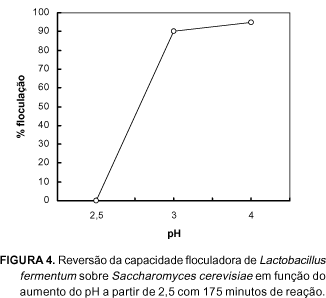The settling of flocculated yeast cells at the bottom of the industrial reactors and the loss of cells in centrifuges can be caused by flocculating bacteria, natural contaminants of industrial alcoholic fermentation. This causes problems leading to loss in ethanol yield and productivity. The present work aims the characterization of Saccharomyces cerevisiae flocculation by Lactobacillus fermentum CCT 1396. The yeast and bacteria cells were mixing and cells flocculation quantified by spectrophotometry. Concentrations of the bacteria in a range from 0.4 to 3.8g/L (dry biomass) were tested in order to determine the optimum bacteria concentration necessary to cause yeast flocculation. The pH effect on the yeast and bacteria cells flocculation was determined. 1.38g/L bacteria was necessary to flocculate, 65.4g/L yeast cells with the contact time betweem the cells (under agitation) for 15 minutes and rest time for 20 minutes. In the pH 3.0 not much effect in the cell flocculation was detected and the cells continued to flocculate, but in the range pH 2.0 -- 2.5 the flocculation was about zero. This technique could be used in yeast flocculation control of alcohol industries, to determine the origen of this flocculation since it is easy and economic with short time demand.
Saccharomyces cerevisiae; flocculation; Lactobacillus fermentum; quantification; alcoholic fermentation







